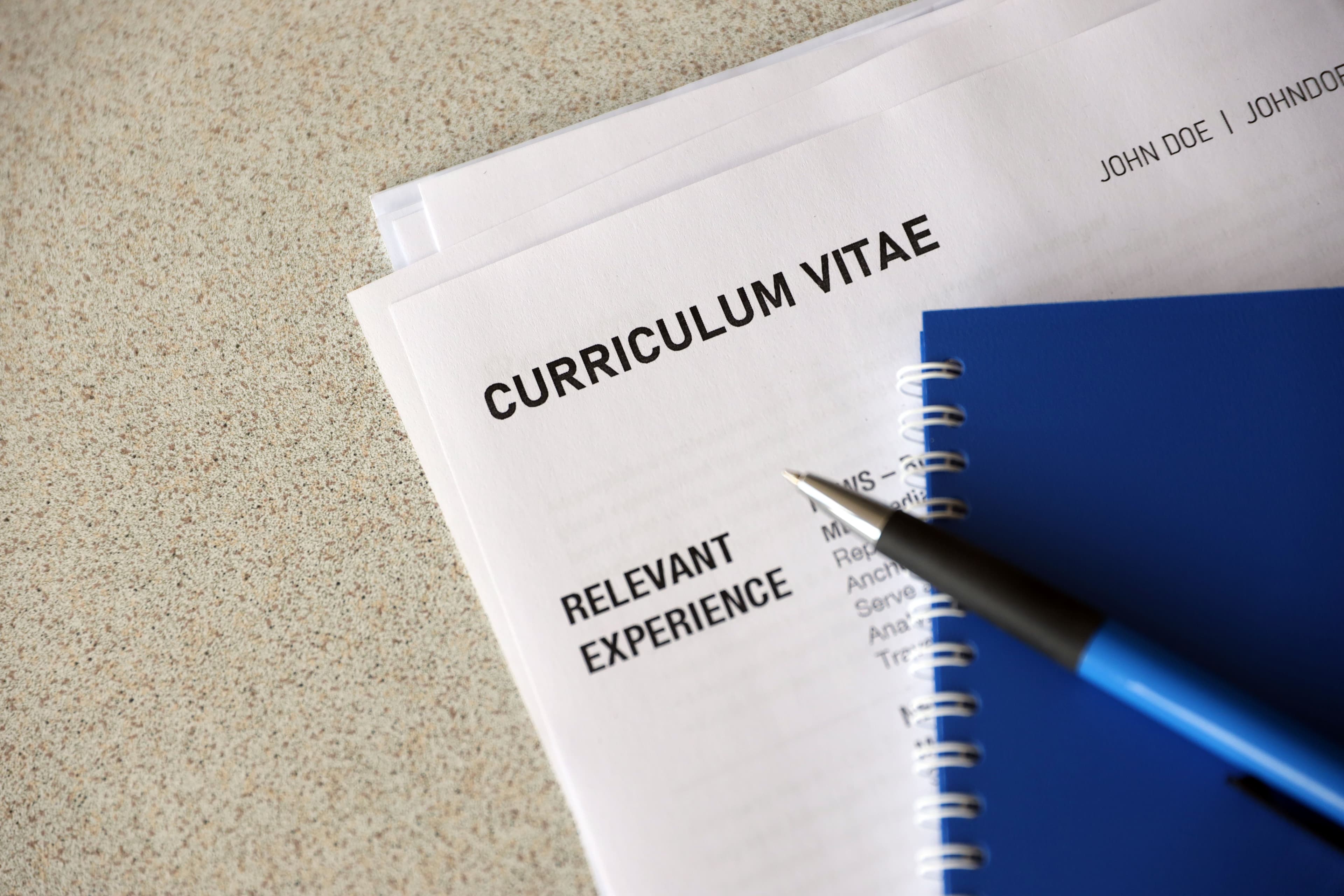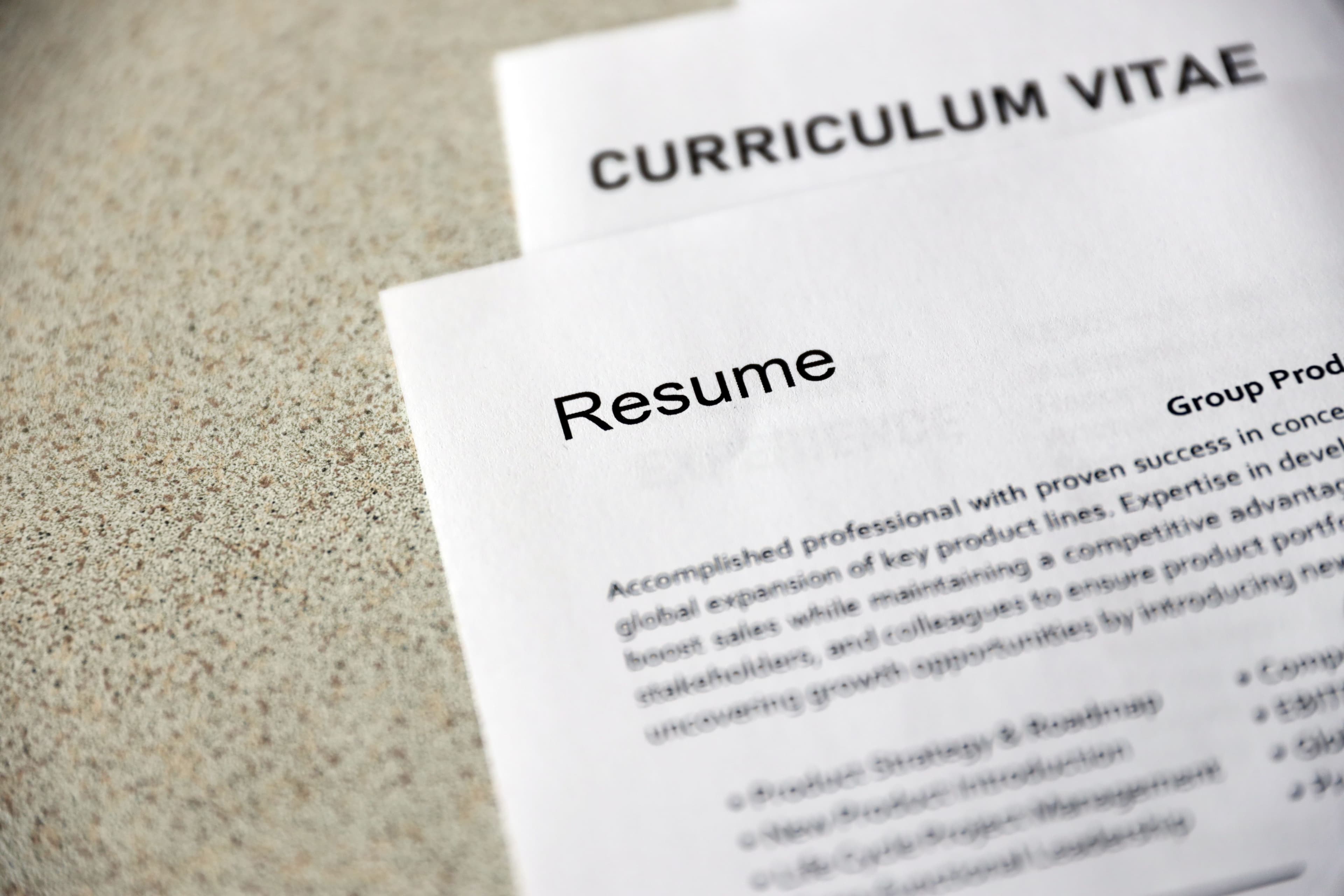Streamline Applications with the Best AI Prompts for Resume Writing
05.06.2025
Job Resources

The number of applications needed to get an interview is climbing, with hiring experts recommending job seekers send out 10-15 applications per week—at minimum. Not to mention each resume should be tailored to the position in question.
But that doesn’t mean you have to start from scratch; especially if you know how to use AI for resume writing. AI tools are widely available and easy to access, meaning every applicant has access to a powerful ally for developing targeted, effective resumes. No need for automated resume builders that create generic content.
This doesn’t mean you just accept whatever output you get from ChatGPT or Claude. The secret is to use AI as a thoughtful assistant rather than letting it take over the creative process.
That means knowing the right AI prompts for resume writing, from extracting insights about job descriptions and researching companies to identifying your strongest qualifications and polishing your content. When used strategically, AI helps you understand what employers are looking for and how to position your experience accordingly, saving time while improving quality.
This guide will walk you through practical AI prompting strategies that enhance your resume without sacrificing authenticity or personal touch.
Understanding the Basics: What Are AI Prompts?
AI prompts are specific instructions or questions you provide to artificial intelligence tools like ChatGPT, Claude, or Gemini to get the information or assistance you need. Think of them as clear directions that guide the AI toward producing useful, relevant responses. When you interact with AI, the quality of your prompt largely determines the quality of help you receive.
These prompts can vary widely in complexity. They might be simple questions like "What skills are in demand for marketing positions?" They can also be detailed, multi-part requests for analyzing a job description, identifying key requirements, and adjusting a resume to reflect the job description. The more specific and structured your prompt, the better the AI can understand exactly what you're looking for.
Learning how to write effective prompts, also known as prompt engineering, is a skill worth developing (and is a great skill for future-proofing your resume in the AI era). Here are the steps involved in writing an effective one:
- Outline the task you need help with
- Explain the desired outcome and format
- Include relevant context about your situation
- Break complex requests down into clear components
Remember that AI tools are assistants, not replacements for your judgment and expertise. They're particularly good at analyzing information, suggesting language, and identifying patterns, but you'll need to review their output critically and make the final decisions about what to include in your resume.
Using AI for Resume Writing
The more you experiment with AI tools, the more you realize how widely applicable they are. To help speed up your understanding in this context, here’s how to write a resume with the help of artificial intelligence.
1) Understanding the Job Description with AI
After finding a position you’re interested in, you can use AI to give you a concise understanding of the key job requirements and get up to speed on any terminology you’re unfamiliar with.
Analyzing Role Requirements
Before you write a single word on your resume, thoroughly understanding the job description is crucial. Since you may be looking at multiple positions at a time, AI can help break down complex job postings into actionable insights.
Here’s a great prompt for quickly gaining an understanding of a role:
"I'm applying for a job and I need your help analyzing the job description thoroughly. Please review the job post below and provide a breakdown that includes the following:
- A summary of the key responsibilities mentioned
- A list of required qualifications and skills
- Any recurring keywords or phrases that stand out
- Observations on the tone and style of the job description (e.g., formal, casual, technical, people-focused)
- Insights into the company's values or priorities as inferred from the language used
- Any industry-specific terminology or jargon that appears relevant
Here is the job post: [Paste the full job description here]"
This comprehensive analysis serves multiple purposes:
- It identifies what the employer is truly looking for beyond the obvious qualifications
- It helps you understand which of your experiences to emphasize
- It provides insight into the company culture and communication style
- It surfaces important keywords that might improve your resume's performance in applicant tracking systems
Remember that while AI is excellent at breaking down information, you should always verify its observations against your own reading of the job description. The goal is to augment your understanding, not replace your judgment.
Decoding Industry-Specific Language
Job descriptions often contain specialized terminology that may be unfamiliar if you're transitioning between industries or roles. AI can help decode these terms and explain their significance.
Try prompting AI with:
"The job description for [position] mentions these technical terms/tools/methodologies: [list terms]. Can you explain what each means in the context of this role, how important they likely are to the position, and how I might address them in my resume if I have related but not identical experience?"
This approach is particularly valuable when:
- You're entering a new field where the terminology is unfamiliar
- The job posting contains acronyms or specialized systems
- You need to understand the relative importance of different technical requirements
- You want to bridge gaps between your experience and the job's specific requirements
2) Company Research and Alignment
Matching your existing skills to stated job requirements is an essential part of updating your resume, but it’s just the start. Set yourself apart by showing that you align with the company's mission, values, and culture as well.
Here’s a great AI prompt for resume writing that’s helpful for company research:
"I'm preparing a job application and want to better understand the company I'm applying to. Please help me research the following information about [Insert Company Name]:
- What is the company's mission and core values?
- What are its main products, services, or areas of operation?
- Are there any recent news, press releases, or major updates about the company?
- What can be inferred about the company's culture and work environment from sources like LinkedIn, Glassdoor, or employee testimonials?
- Any other insights that would help me tailor my resume and cover letter to align with the company's identity."
This comprehensive research allows you to:
- Reference company initiatives or values that align with your experience
- Understand what the company prioritizes in its employees
- Identify recent developments you might subtly acknowledge in your application
- Gain context about the work environment to highlight relevant soft skills
While AI can gather this information efficiently, remember to verify key points through the company's official channels like their website, LinkedIn page, or recent press releases to ensure accuracy.
Once you understand both the job requirements and company context, AI can help identify how your interest areas, work values, and work styles align best with what the employer seeks.
The following prompt from our checklist helps bridge this gap:
"I'm preparing a job application and want to better understand how well I align with the role. Please analyze the job description below and help me with the following:
- Based on the responsibilities and qualifications, what do you think the company is prioritizing most in this role?
- I will provide my skills and experience — please help me map my background to the role's key requirements. Highlight areas of strong alignment and note any gaps I may need to address.
Here is the job description: [Paste job description here]
Here is my background (skills, experiences, or resume): [Paste resume or description of skills/roles here]"
This analysis helps you:
- Understand which of your experiences to emphasize most prominently
- Identify potential gaps you might address in your cover letter
- Prioritize content to ensure the most relevant qualifications appear first
- Frame your experience in terms that resonate with this specific employer
This targeted approach ensures your resume speaks directly to what matters most for the position.
3) Tailoring Experience and Performance Metrics
Generic job descriptions rarely impress hiring managers. AI can help transform basic responsibility statements into powerful achievement narratives.
Try prompting AI with:
"I need to improve these resume bullet points to focus more on achievements and impact rather than just responsibilities. Please help me transform these statements to emphasize results, quantify impact where possible, and use stronger action verbs:
[Paste your current bullet points here]"
This transformation process:
- Shifts focus from what you were supposed to do to what you actually accomplished
- Introduces variety in your action verbs to avoid repetitive language
- Creates more compelling, results-oriented content that captures attention
- Demonstrates your value through concrete outcomes rather than tasks performed
Remember to verify that any revised bullet points remain truthful and accurately represent your actual accomplishments.
One of the most challenging aspects of resume writing is quantifying your impact, especially in roles where metrics aren't obvious. AI can help brainstorm potential measures of success you might not have considered.
A useful prompt for this purpose is:
"I worked as a [job title] at [company], where my main responsibilities included [list key responsibilities]. While I know quantifying achievements is important, I'm struggling to identify measurable impacts. Can you suggest potential metrics or quantifiable achievements that might be relevant to this type of role?"
This approach helps you:
- Discover metrics you hadn't considered relevant
- Translate qualitative successes into quantitative terms
- Create more impactful achievement statements
- Stand out from other candidates with similar experience
Even if AI suggests metrics you don't have precise numbers for, it might inspire you to estimate improvements or recall achievements you hadn't thought to include.
4) Optimizing for Applicant Tracking Systems (ATS)
Most large companies use Applicant Tracking Systems to screen resumes before human eyes ever see them. AI can help ensure your resume contains the right keywords without resorting to keyword stuffing.
Try this prompt for ATS optimization:
"I want to optimize my resume for ATS systems without compromising readability or engaging in 'keyword stuffing.' Based on this job description [paste job description], what keywords should I naturally incorporate into my resume? Please also suggest how I might integrate these terms in a way that reads naturally."
This approach:
- Identifies both explicit and implicit keywords from the job posting
- Helps you integrate terms naturally throughout your resume
- Improves your chances of passing initial screening algorithms
- Maintains readability for the human reviewers who will ultimately make hiring decisions
Even the best content can be undermined by formatting that confuses ATS systems. AI can help assess whether your resume's structure will be ATS-friendly.
A helpful prompt is:
"I want to ensure my resume is ATS-compatible. Here are my current section headings and formatting choices: [describe your format]. Are there any potential issues that might cause problems with ATS systems? What adjustments would you recommend?"
This review helps you:
- Identify potentially problematic formatting elements
- Choose standard section headings that ATS systems recognize
- Avoid common formatting pitfalls like tables, headers/footers, or unusual fonts
- Strike a balance between visual appeal and machine readability
Remember that while fancy templates may look impressive, they are often cited by hiring managers and recruiters as a top resume writing mistake. Simplicity and clarity often work best for both ATS systems and human reviewers.
5) Refining Your Cover Letter and Resume Copy
The trend right now is for resumes to be as short as possible to make things easy for time-crunched employers. AI-assisted resume writing helps you prioritize the most relevant content and use impactful, industry-specific language.
Content Prioritization
With limited space on your resume, choosing which experiences to highlight and which to minimize requires strategic thinking. AI can help you prioritize content for maximum impact.
Consider this prompt:
"Based on this job description [paste job description] and my work history [paste work history], which experiences should I emphasize most prominently on my resume? Are there any experiences that seem less relevant that I could minimize or remove?"
This analysis helps you:
- Structure your resume with the most relevant content first
- Identify experiences that may not add value for this particular application
- Make informed decisions about which roles or accomplishments to elaborate on
- Create a more targeted document that speaks directly to the employer's needs
Language Enhancement
Even strong content can be undermined by weak language or passive constructions. Whether you’re struggling with how to write a cover letter or your resume, AI can help elevate your word choice and phrasing for greater impact.
Try this prompt:
"Please review the following resume bullet points and suggest improvements to make the language more powerful, concise, and impactful. Focus on:
- Replacing passive voice with active language
- Upgrading weak verbs to stronger alternatives
- Eliminating unnecessary words
- Clarifying vague statements
[Paste your current bullet points]"
This review helps you:
- Create more dynamic, engaging content
- Communicate more information in limited space
- Avoid common linguistic pitfalls that weaken your message
- Maintain a consistent, professional tone throughout your document
Best Practices and Limitations of AI-Assisted Resume Writing
As powerful as AI tools can be for optimizing your resume, understanding their proper use and inherent limitations is essential for effective, ethical use.
Maintaining Authenticity
While AI can provide valuable assistance, your resume must authentically represent your experience and voice. Always review AI suggestions critically.
Be mindful of these guidelines:
- Verify that any AI-suggested achievements accurately reflect your actual accomplishments
- Check that suggested language aligns with your professional voice and industry standards
- Ensure that any statistics or metrics remain truthful and verifiable
- Remember the checklist advice: "Always note to check the sources AI is using to help"
Your resume is ultimately a reflection of your unique career discovery journey—AI should enhance your presentation, not replace your authentic professional self.
Ethical Considerations
There's a clear line between using AI to better articulate your qualifications and misrepresenting your experience. Ethical use of AI for resume writing means:
- Never claiming skills, experiences, or accomplishments you don't possess
- Being honest about your qualifications and role in achievements
- Using AI to clarify and strengthen authentic content, not fabricate it
- Viewing AI as a writing and research assistant, not a replacement for personal effort
Remember that you may be asked to elaborate on anything in your resume during an interview. Only include what you can confidently discuss in detail.
When used thoughtfully within these guidelines, AI can be an invaluable tool that helps you present your authentic professional story in the most compelling and effective way possible.
Start Using AI as Your Resume Partner
Remember that AI is most effective when you approach it with specific, well-crafted prompts that direct its analysis toward your particular needs. The prompts included in this guide provide an excellent starting point, but don't hesitate to adapt them to your specific situation.
Your resume is often your first impression with a potential employer—make it count by combining your unique professional story with AI's ability to help you tell it more effectively.
Ready to put these strategies into action? Get our Job Application Checklist, which comes with all of our templates, to access all the AI prompts mentioned in this article, plus additional guidance to ensure your application stands out for all the right reasons.
Subscribe to My Career Shop Content
Stay up to date with Blog Posts and Podcast Episodes!
Your One Stop Shop For All Career Resources
Whether you are exploring new career paths, building your resume, or preparing for your next opportunity, our tools, templates, and guidance are designed to help you navigate your career journey with clarity and confidence.
Copyright © 2025 My Career Shop. All rights reserved.

























